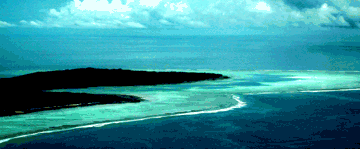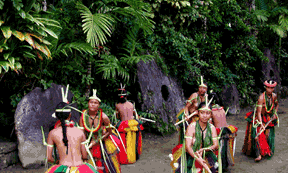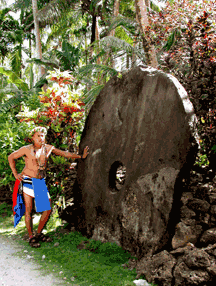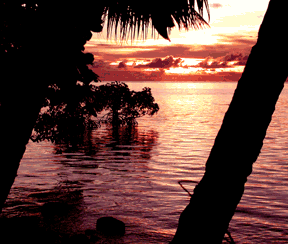 Our group of five divers was clinging to the reef
peering above the protective rocks and boulders for a glimpse of a sea creature, one whose shadow would cover us all as he swept by flapping huge wings. A strong tidal current was trying to rip us from
our attachments out to sea just a few hundreds yards away. We shuffled around the coral ridges seeking more protection from the current.
Our group of five divers was clinging to the reef
peering above the protective rocks and boulders for a glimpse of a sea creature, one whose shadow would cover us all as he swept by flapping huge wings. A strong tidal current was trying to rip us from
our attachments out to sea just a few hundreds yards away. We shuffled around the coral ridges seeking more protection from the current.
Finally, a shadow appeared 20 feet above us in the murky Mil Channel waters, and the giant Manta Ray swam by without even noticing us. Rulers of the underwater empire in this area of the South Pacific, the
Manta sightings on the island of Yap, southwest of Guam, are famed. Since 1989 when Yap Divers, the first full service professional dive operation, opened for business, they have attracted scuba divers from all
over the world.
 At times, the legendary Mantas, which weigh up to
a ton, will pass close enough to touch and stare curiously at the divers. At other times, the gentile giants are difficult to see in roily waters from a storm on an outgoing tide. The Mantas and the miles upon
miles of unspoiled reefs are only one of the island's attractions. The unique giant stone money and the people are other attractions that make this isolated spot in the Micronesian islands worth long distance
travel. To get there from the states, you fly to Honolulu and then fly Continental Micronesia on to Guam, which is an 8-hour trip. Then you'll take another Continental Micronesia flight one hour on to Yap.
At times, the legendary Mantas, which weigh up to
a ton, will pass close enough to touch and stare curiously at the divers. At other times, the gentile giants are difficult to see in roily waters from a storm on an outgoing tide. The Mantas and the miles upon
miles of unspoiled reefs are only one of the island's attractions. The unique giant stone money and the people are other attractions that make this isolated spot in the Micronesian islands worth long distance
travel. To get there from the states, you fly to Honolulu and then fly Continental Micronesia on to Guam, which is an 8-hour trip. Then you'll take another Continental Micronesia flight one hour on to Yap.
The State of Yap is located in the Western Caroline Islands. With several islands and atolls covering over 100,000 square miles of water, it is made up of a total land mass of only 46 square miles, a little over 38
of which makes up Yap proper. There are four volcanic islands that form the majority of Yap: Rumung, Maap, Gagil-Tomil, and Yap. Yap and Gagil-Tomil are the two largest islands and are separated by a
canal finished during the German administration.
Yap is an interesting island. It has several cross-island waterways, inlets and channels, and an extensive
shoreline, and the six-hundred-foot Tabywol Mountain. On Maap, although much of the land is rugged and hilly, lush pockets of vegetation are visible in every direction. Red clay valleys and ridges are distinctive to
Gagil-Tomil.
 Other dives worth mentioning among the 30 dive sites are Yap
Caverns, Gilman Wall, Lionfish Wall, Valley of the Rays and Sharks Canyons. There are many reefs still waiting to be discovered in the 134 islands that make up Yap. There are also
great snorkeling sites around the island that are accessible from land or by small boat, if the waters are clear and undisturbed by rainy weather. Since waters inside the reef are privately owned, it
is necessary to obtain permission before getting wet on some of the beautiful reefs.
Other dives worth mentioning among the 30 dive sites are Yap
Caverns, Gilman Wall, Lionfish Wall, Valley of the Rays and Sharks Canyons. There are many reefs still waiting to be discovered in the 134 islands that make up Yap. There are also
great snorkeling sites around the island that are accessible from land or by small boat, if the waters are clear and undisturbed by rainy weather. Since waters inside the reef are privately owned, it
is necessary to obtain permission before getting wet on some of the beautiful reefs.
Fishing for mahi mahi (dolphin), tuna, and wahoo is popular with some visitors. Two sportfishing charter operations exist offering
expeditions on a regular basis. Kayaking the fringing reef also is becoming popular in Yap. A visitor can also go mountain biking, hiking on ancient, centuries old stone paths or visit the Stone
Money Banks on the island. Yap is certainly a mix of past and present where an ancient culture exists side by side with the 21st Century.
The Stone Money for which Yap is famous consists of huge
round disks of solid stone rock than can weigh hundreds of pounds. The massive "wheels" quarried in far off Palau, are usually displayed side by side outdoors in a "bank" at one of the thatched-roof villages on the
island. Men's Houses are usually beside the banks and money that seems un-moveable.
Since the island basically opened for tourist in 1989, the secluded culture has not changed a lot. Many
natives still wear traditional garb. Some men wear bright loin cloths and women wear grass skirts and leis and dance topless at least at their ceremonies and events (and in some cases in everyday life). Village
tours, dancing presentations and the handicraft of Yap highlight a visit to this island.
The average temperature of 82 degrees Fahrenheit on Yap varies little throughout the year. Rainfall
averages 120 inches a year and is seasonal; heavy rains occur during summer months. The transitional months of May, June and November are peak typhoon season. Since the temperatures in Yap are
moderate and fairly constant, lightweight clothing and very casual attire is always acceptable. For women, lightweight cotton dresses, blouses and skirts are acceptable attire. However, it is considered highly
offensive for women to bare their thighs in public, such as wearing short shorts, bikinis or mini-skirts (unless diving or sunbathing).
Nearly all the land in Yap is privately owned. Once off the main roads expect to be on private property. This includes stone paths, yards, coconut groves and beaches. The stately Men's Houses that are found in
many villages are much like a private clubhouse. Picture taking of Yapese generally requires their permission. Although Yapese, Ulithian, Woleian, and Satawalese are the four indigenous languages in
Yap, English is the official language. U.S. currency and electricity is identical to ours.
 You may not see the luxury of larger islands, but the
intriguing attractions of Yap will make your jaunt to Micronesia unforgettable!
You may not see the luxury of larger islands, but the
intriguing attractions of Yap will make your jaunt to Micronesia unforgettable!
Editor's Note: For general information on Yap, contact Yap Visitors Bureau, Bldg. #1, YVB Main Dr., Colonia,
Yap FM 96943, Western Caroline Islands or phone (691) 350-2298. For more information on the island's best accommodations, contact Traders Ridge Resort, phone toll free (877) 657-4695 or (691) 350-6000, Fax
(691) 350-4279 or write P.O. Box B, Colonia, Yap FSM 96943; email Tradersridge@mail.fm or visit their website at www.tradersridgeresort.com. For information on the diving, contact Yap Divers at (691)
350-2300, visit their website at www.mantaray.com or email yapdivers@mantaray.com. For information on flights, call Continental Airline Vacations at 800-634-5555 (ext. 5).

